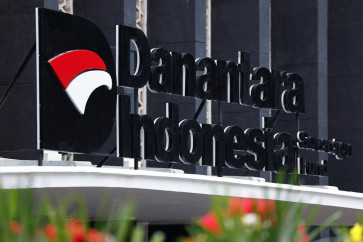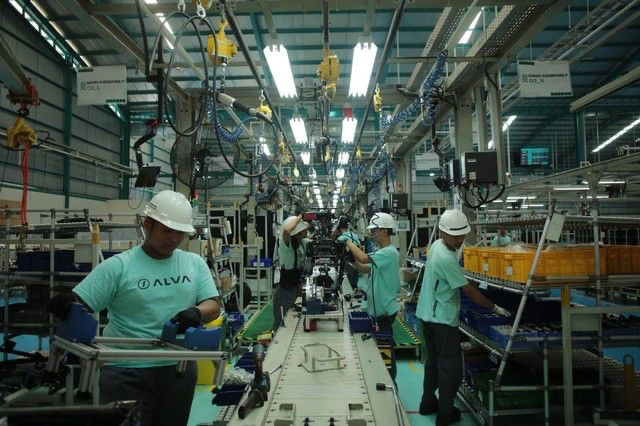Popular Reads
Top Results
Can't find what you're looking for?
View all search resultsPopular Reads
Top Results
Can't find what you're looking for?
View all search resultsJakarta Election: Candidates offer no new steps on floods
For as long as history can record, flooding has threatened the area that has grown into the Jakarta we know today
Change text size
Gift Premium Articles
to Anyone
F
or as long as history can record, flooding has threatened the area that has grown into the Jakarta we know today.
The Tugu Inscription from the age of Great King Purnawarman in the 5th century — evidence that the center of the Kingdom of Tarumanegara was located around the modern-day Tanjung Priok in North Jakarta — recorded the construction of an 11-kilometer-long canal to divert a river.
Some historians believe that the canal’s construction was a measure to manage flooding in the kingdom’s capital.
From the 5th century to the 21st century, flooding has remained a major issue.
The worst flooding in the area’s history inundated about 70 percent of Jakarta in 2007, killing at least 57 people and driving more than 450,000 from their homes.
Aware of the grave issues at hand, the six candidates competing in this year’s gubernatorial election have each included flood management in their campaign programs. However, none of the candidates offer solutions that represent a departure from measures that have been suggested, talked about and planned out for decades.
Incumbent Governor Fauzi Bowo listed warding off the threats of high wave from the coast in the north and controlling massive water flows from the highlands south of the city.
Fauzi said he would continue with plans to construct a new harbor wall in Jakarta Bay, which he called the giant seawall, in 2025.
In an effort to protect Jakarta from upstream threats, he promised to build dams and reservoirs. In between the two, the incumbent also planned to dredge the city’s main rivers and canals.
The central government and the Jakarta administration will begin work in October this year to repair dikes and dredge 11 canals and four reservoirs in the next five years, financed primarily by a loan from the World Bank.
Fauzi said he would focus on revamping Ciliwung, Krukut, Pesanggrahan, Angke and Sunter Rivers and their banks. Fauzi’s competitors listed similar programs with minor variations. Independent Hendardji Soepandji has spoken of developing a waterfront area in the northern part of the city, without going into extensive detail.
Hidayat Nurwahid added to Fauzi’s list of programs a plan to create 76 million biopores across the capital and construct a multipurpose deep tunnel — an idea that was rejected by many experts when it surfaced in 2007.
Joko “Jokowi” Widodo, mayor of Surakarta, Central Java, has similar plans to his contenders, but he underlined the need to form a joint authority with neighboring administrations to coordinate flood management.
South Sumatra Governor Alex Noerdin, has only listed three plans to overcome flooding: Create 2 million absorption wells and 1 million biopores, hold labor intensive projects on flood management at the subdistrict level and build four polder systems and a dike in northern Jakarta.
Independent Faisal Basri does not include flood management in his top five priority programs, saying that flooding should be considered as an integrated part of drainage problems and clean water provision.
Faisal similarly pressed the necessity of a joint authority body on flooding.
An urban planning analyst at Jakarta-based Trisakti University, Nirwono Joga, said that on the macro-level, Jakarta’s new governor should focus on increasing the number of green areas and creating catchment areas to absorb as much rainwater as possible. “On the intermediate level, drainage system dredging and revitalization of reservoirs and dams will never cease to lose their importance,” Nirwono said.
Major moves in managing flooding have often taken a long time to materialize in the capital.
The East Flood Canal and the West Flood Canal were conceived by Dutch engineer Herman van Breen in 1918 during the colonial era. While the western canal was completed during the colonial era, the eastern canal had to wait until 2003 to be constructed and until 2009 to be operated. The canal, which crosses five major waterways in East Jakarta, is not yet fully complete.
The dredging of Jakarta’s waterways has also been a sluggish affair.
The city’s drainage system, a legacy of 1960s-era urban planning, consists of a supposedly comprehensive network of 13 natural and artificial rivers flowing through Jakarta, along with their tributaries, drains and canals.
A massive dredging plan was created in 2007, but the city has spent the last two years waiting for the central government to disburse the funds from the World Bank.
The World Bank provided a loan of US$139.64 million for the project, with the central government and the city administration chipping in a total of $49.71 million.
In the past three years, the administration worked on repairing micro-drainage channels at 123 of the most flood-prone streets throughout the city.
The National Disaster Mitigation Agency (BNPB) has said that Jakarta’s rivers and waterways do not have the capacity to drain water from torrential rains quickly enough to prevent flooding.
The agency said that each of the main waterways only had the capacity to drain between 17 and 80 percent of rain water during downpours, rendering 13 rivers and two flood canals passing through the capital nearly useless.
BNPB warned that all areas in the capital were vulnerable to flooding when 300 to 400 millimeters of rain per hour hit the city, which could happen during the peak of the rainy season. The normal rainfall rate in city is between 50 and 100 millimeters per hour.
— JP/Andreas D. Arditya










